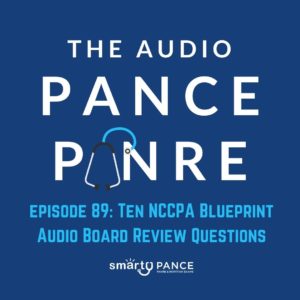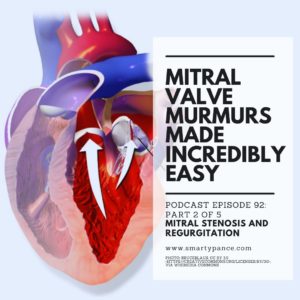Podcast Episode 89: Ten PANCE, PANRE, and Rotation Review Questions
Description
 </figure>
</figure>Welcome to episode 89 of the Audio PANCE and PANRE PA Board Review Podcast.
Join me as I cover ten PANCE, PANRE and EOR review questions from the Smarty PANCE Instagram/Facebook page and the smartypance.com board review website.
Special from today’s episode:
- Follow Smarty PANCE and The Daily PANCE Blueprint on Instagram
- Follow Smarty PANCE and The Daily PANCE Blueprint on Facebook
Below you will find an interactive exam to complement today’s podcast.
The Audio PANCE/PANRE and EOR PA Board Review Podcast
I hope you enjoy this free audio component to the examination portion of this site. The full board review course includes over 2,000 interactive board review questions and is available to all members of Smarty PANCE.
- You can download and listen to past FREE episodes here, on iTunes, Spotify, on Google Podcasts, Stitcher, and most podcasting apps.
- You can listen to the latest episode, take an interactive quiz, and download more resources below.
Listen Carefully Then Take the Practice Exam
If you can’t see the audio player, click here to listen to the full episode.
Podcast Episode 89: Ten PANCE/PANRE and EOR Blueprint Questions
1. The definition of amblyopia is . . .
A. Congenital cataracts noted at birth
B. Retinal detachment seen in premature children
C. Irregular pupillary size
D. Increased distance between the medial and lateral canthus
E. Subnormal visual acuity in one or both eyes despite correction of refractive error
Answer: E. Subnormal visual acuity in one or both eyes despite correction of refractive error
Amblyopia, also called lazy eye, is a disorder of sight in which the brain fails to process inputs from one eye and over time favors the other eye. It results in decreased vision in an eye that otherwise typically appears normal
- Amblyopia is not correctable by refractive means
- Amblyopia occurs in early childhood when nerve pathways between the brain and an eye aren’t properly stimulated
- It may be caused by strabismus (crossed eye); uremia; or toxins, such as alcohol, tobacco, lead, and other toxic substances
- Symptoms include a wandering eye, eyes that may not appear to work together, poor depth perception, blurred vision, or double vision. Both eyes may be affected
DX: Screening to detect amblyopia in all children younger than five years of age
- Screening includes vision risk assessment at all health maintenance visits and vision screening at age three, four, and five years of age
TX: Treatment includes correction of refraction error as well as forced use of the amblyopic eye by patching the better eye
- Some children cannot tolerate the patch, in which case the good eye is blurred with glasses or drops (penalization therapy) to stimulate proper visual development of the more severely affected eye
- It is more resistant to treatment at an older age; thus, children should be treated early
View lesson: Amblyopia
A 45-year old woman being managed for ulcerative colitis, developed abdominal pain, vomiting, diarrhea, the passage of blood and mucus per rectum, and fever. On examination, she was pale, febrile (temp: 102.2 C), moderately dehydrated, heart rate: 124bpm. There was abdominal distention and tenderness, bowel sounds were hypoactive. Lab results showed Hb: 9g/dl, WBC: 14 x 109/L, elevated CRP. Stool was negative for C. difficile. HIV status was negative. Abdominal radiograph showed dilated transverse colon of about 11 cm. What is the most likely diagnosis of this patient?
A. Hirschsprung’s disease
B. Cytomegalovirus colitis
C. Toxic megacolon
D. Kaposi’s sarcoma
Answer: C. Toxic megacolon
The hallmarks of toxic megacolon (toxic colitis) are nonobstructive colonic dilatation (>6 cm) and signs of systemic toxicity. It occurs following complications from causes of colitis e.g. ulcerative colitis as is the case in the index patient.
Incorrect Answers:
- Hirschsprung’s disease (choice A) presents with chronic constipation. Patients are not usually toxic except when intestinal perforation occurs.
- Cytomegalovirus colitis and Kaposi’s sarcoma (choice B and D) Occurs in immunocompromised persons.
View lesson: Toxic megacolon
3. Which of the following is not transmitted by blood?
A. Hepatitis A
B. Hepatitis B
C. Hepatitis C
D. Hepatitis D
Answer: A. Hepatitis A
Hepatitis A is transmitted via the fecal-oral route
Incorrect Answers:
- Hepatitis B can be transmitted via blood and blood products through close living quarters/playground play as a toddler, vertical transmission, infected unscreened blood, needle stick injury, etc.
- Hepatitis D is transmitted via blood.
- Hepatitis C is transmitted via blood and blood products through Intravenous drug misuse, unscreened blood products, needle stick injury, vertical transmission etc
View lesson: Acute and Chronic Hepatitis
4. When is PKU testing performed?
A. 24 weeks gestation
B. 24 to 48 h after birth
C. 48 to 72 h after birth
D. at the first well-child visit
Answer: B. 24 to 48 h after birth
In the US and many developed countries,







